How to eat healthily while travelling
How to eat healthily when travelling
Hello everyone! Today's post is dedicated to everyone who is worried about their health and wants to lead a healthy lifestyle. As we know, it is quite easy to live a healthy lifestyle when you are in your own home. You go to the supermarket, buy what you need, you cook and there you are, you've done it. Sometimes you'll have a craving, an ice-cream, a pizza, etc. All of this is really different when we travel, especially if it is a long trip or if we have this syndrome of endless travelling and we go on small getaways all the time. Like this, we all know that it is a lot more difficult to ensure that all the meals that we have during the day are healthy.

This is why in today's post, I am going to give you some advice and tips, so that at least the majority of mouthfuls that you take will be healthy options. A lot of these recommendations are also linked to saving money, as it is evident that if you plan well, eating things that come from natural materials, you can save money. With travelling, it's the same thing. So here we go:
Breakfast: homemade
Starting with breakfast, there are lots of things to keep in mind.
I will start by talking about accommodation where breakfast is not included. When I do 3-day or weekend trips, I try to bring my home-made breakfast, for example, an oat biscuit, banana and cocoa powder which can last me for 2 days. I put it in tupperware and this is my breakfast for the two days. It is a really good way of saving money, knowing what you are eating, and also, eating what you like. If for whatever reason this option is tiresome, because the thought of carrying your food doesn't convince everyone or you're simply going to be doing a longer trip, you can also go to a supermarket and buy your breakfast. The breakfast, bearing in mind the food habits of our society, should be the easiest meal to buy. It doesn't require much thought. A really good option would be to buy a natural yoghurt and add the toppings on that you want: dry fruits, dark chocolate, chopped fruit. For me, this is one of the easiest options but obviously there are infinite other options.

If you are one of these people that needs an oven, microwave or hob to make their breakfast, my advice is that you search for an accommodation which has these facilities. Normally, any Airbnb would usually be a good option. Thus, during your trip you can prepare exactly what you eat for breakfast every day. This also applies for lunch and dinner, but generally and from my experience, breakfast is always the most appealing meal to make at home.
Later, I will leave you a really funny photo of my friends on the floor making their food for the next day. This photo was taken in an Airbnb in Austria, which was located in the middle of nowhere, amongst mountains, and unfortunately, it didn't have a kitchen (we forget to check that when we reserved it). Therefore, we didn't have any choice but to adapt and improvise. Open the tupperware, cut vegetables, open the tin of beans, mix it all up and keep it for the next day. Without a doubt, if someone doesn't eat healthily it is because they don't want to.

Breakfast: included
In second place, I will talk about accommodations where breakfast is included in the price, as there are several things to mention. If you stay in a good hotel, you will have a buffet breakfast with a big choice of foods and products. This can really help you during the stay and for planning your meals, but at the same time, it is a double-edged sword, as there are more chances of you making a bad choice. Just in case, because sometimes it seems we need to be reminded, try to avoid the shop-bought bakery products, the cold-cuts, the pre-packed juices and the soft drinks. A good option would be any fruit, vegetable, any dry fruit, yoghurt with muesli, and if you fancy a bit of protein to start the day with a kick, you could make the most of the opportunity to have a French tortilla or a cooked egg, common options in the majority of buffets. The advantages of buffets. Ah, yes, and make the most of it by having a good coffee or tea to receive a big boost of energy to start your day.
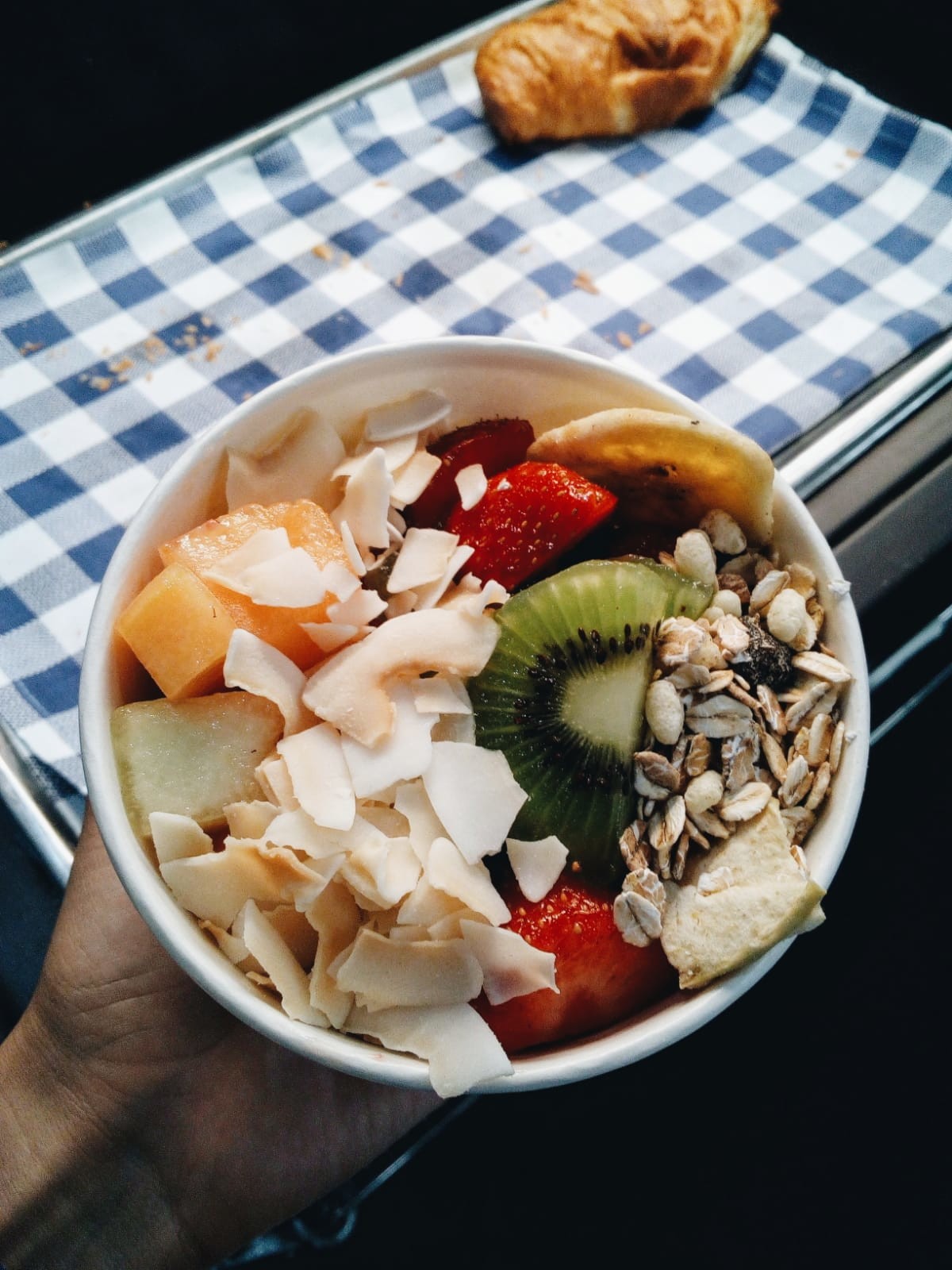
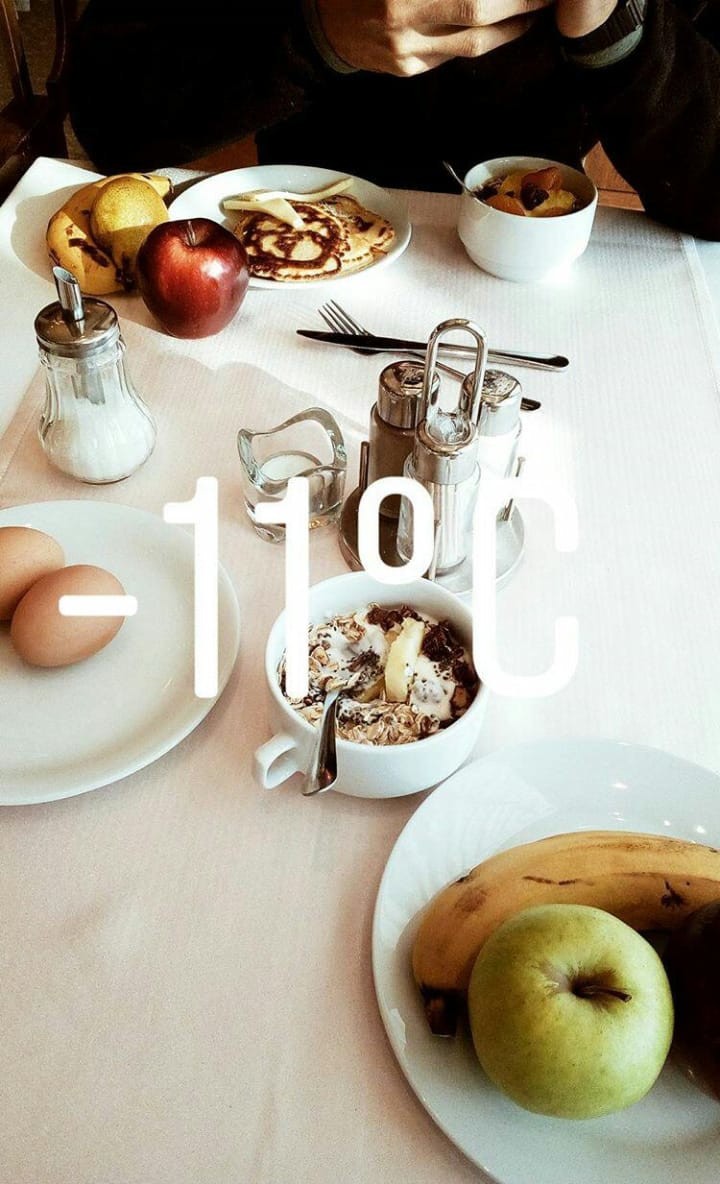
Lunch and snacks
Plan your snacks, lunch time or early afternoon meals. As a lot of you know, the plans of trips can go awry. Flights get delayed, trains break down, there are big queues to see the attractions and in the end, plans don't go like we hoped they would. This is why we should always be prepared and bring something with us to eat, just in case. A good option could be a bag of dried fruit, as it is easy to carry around and for times when you have a craving, it is a good idea because it fills you up quite a lot. Other options could be a piece of fruit or even hummus which they sell in the supermarket, which is usually made with healthy ingredients. By doing this, we will avoid snacking or going to ice-cream shops or fast food stalls, which are so common in big cities, like burger restaurants, pizzerias at street level, kebab shops or McDonald's.
Water
Always bring a bottle of water with you, better if it is an eco-friendly one. I think that I have already talked about this in another post, but just in case, I'll repeat it. It is a good idea to keep hydrated and there is normally always a fountain with drinking water in cities to fill your bottle up.
Tupperware
Always bring tupperware, just in case. Before, I told you that you could bring your breakfast with you in tupperware, but even if you don't bring it with you full at the start of the trip, still bring it empty as there is always the option of cooking in our accommodations; and this will help us to eat healthily during the rest of our trip. Also, this lets us have a break in the typical places with tables to picnic at, which are usually surrounded by nature, and they are really cool, as you can see in the following photo.
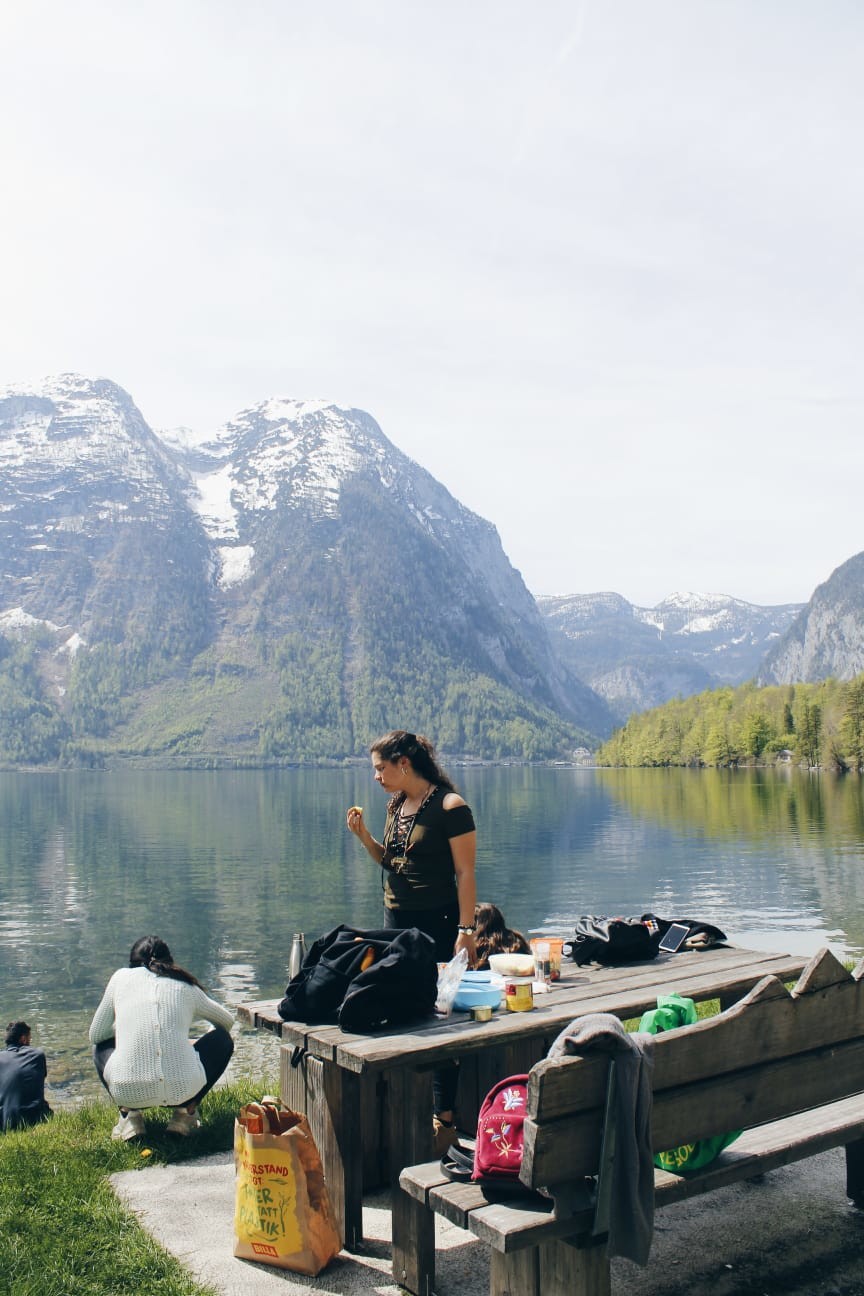
Linked to this, a piece of advice I'd give you is to bring a spray bottle of extra virgin olive oil with you and a salt shaker, as it is really convenient to carry with you, as well as safe. This will help you to give a healthier touch to your meals and also, in case you need to cook in your accommodation.
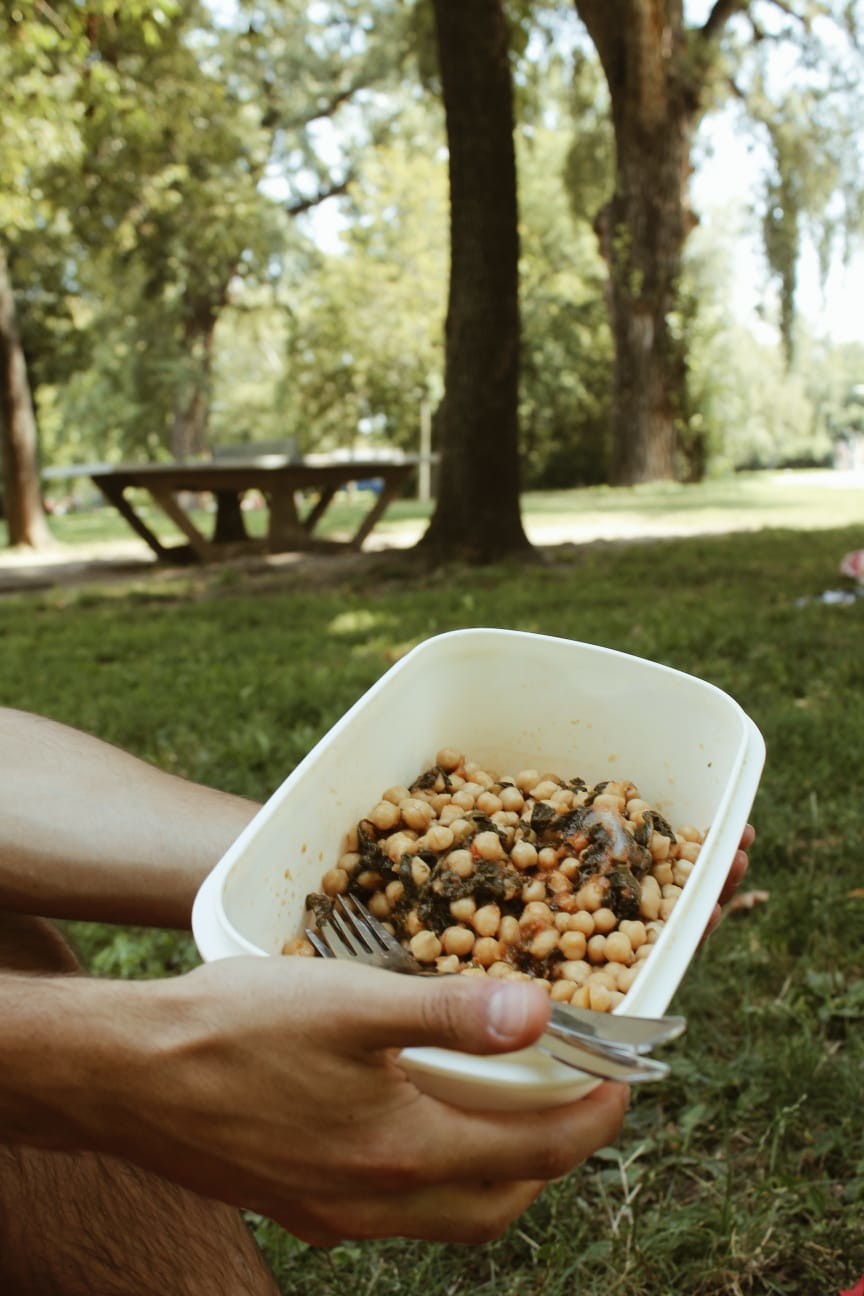
Choices in restaurants
In restaurants, take your time to find out what is the best option, always enjoying the food. Avoid foods with sauces, chips and try to include a portion of vegetables and some kind of food with protein on your plate. As if for the rest of the day you eat raw food that you have bought from the supermarket, this is usually the most difficult food source to obtain throughout your day, at least in sufficient amounts. Also, bear in mind that usually the simple dishes, with a few ingredients, are the best options. I repeat, usually, as there are exceptions; as it could be a salad with lots of healthy ingredients, so this would be a good choice (as you can see in the next photo: salmon salad).

Obviously you can set the bar of what you eat, as well as the limits. There is nothing wrong if sometimes you don't include vegetables in your daily meals, but if there is a dish that you like that comes with vegetables on the menu and you can include it... why not have it?
Avoid having dessert at the restaurant
Avoid having dessert at the restaurant. They are tempting, but here is where your will power has to come into play. To have another reason to not order one, think that this is also a way of saving money. If you are in a country like Italy where avoiding dessert is particularly difficult, who doesn't fancy pannacotta or tiramisu? Then follow this, share the dessert. I always say that a desert should be small, and honestly, in restaurants they are the size of a brick. If you share it, you will eat less and save more. So all positives. Sharing is life.
Don't wait a long time between having your main meals.
When we go for a long time without eating and we are really hungry, we normally make worse choices because we have an empty stomach, or we at least aren't as full. This is why I recommend that you go food shopping when you aren't hungry. Thus, if you have a full stomach, you can choose your meals better as you won't be tempted as much by the desserts or the insane meals. Again, try and eat in between your main meals, for example, your lunch and dinner, and it is here that again, I will mention snacks. In addition to this, when we are really hungry and we finally have some food, we usually eat a lot more rapidly. More than eating, we devour our food, and this isn't good for our stomach and we end up eating more because we don't feel full until a lot later on.
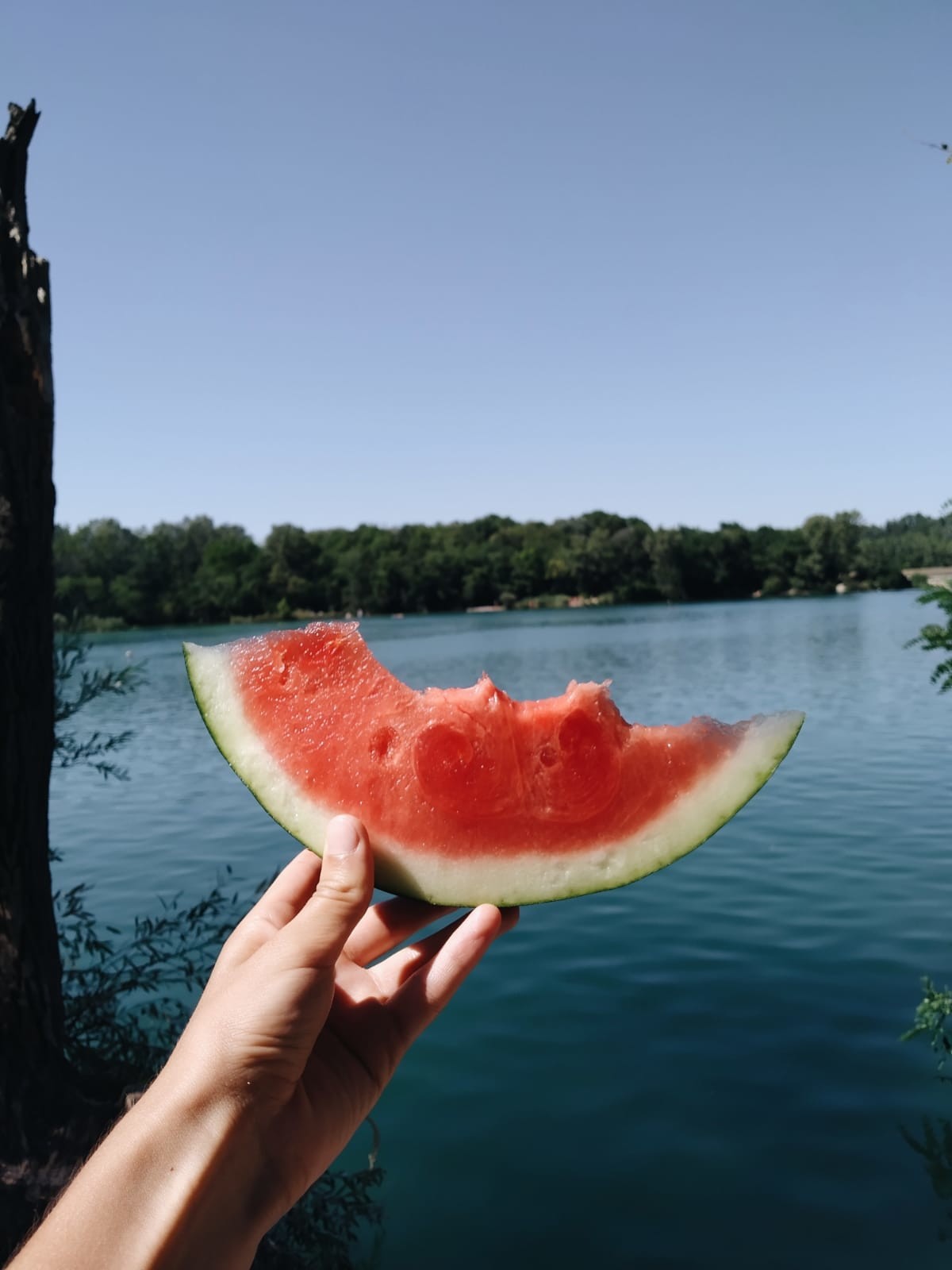
Buying food in the supermarket
Finally, and this is really optional, try to make sure that your breakfast and lunch are made up from ingredients bought in the supermarket. Therefore, you only have one meal that is from a restaurant. You can change the order, that isn't a problem. From here, I can't do anything more than to advise you not to eat more than you should. Don't have eyes bigger than your belly and be aware of how much food your belly can actually take. This is also applicable to travelling whilst saving money.
Also, going to the supermarket is another way of getting to know the culture of the country that you are visiting. Personally, I really like checking out what products there are in the countries that I visit, that for example, those that we don't have in Spain or that are quite hard to get hold of.
This also applies to markets. If you go shopping in the local markets, you can usually get hold of good quality ingredients which are quite fresh. Even in the markets which are in loads of big cities, they still have a multitude of little stalls with traditional food to take away or eat there on the spot.
Listen to your body
The tips that I have just given you are general ones, and nobody knows your body better than you. Depending on the type of trip, the intensity of it and the place, I organise my meals in one way or another and choose some options or others. For example, if I am doing a trip in nature where the main activity is walking in the mountains; when I am eating I try to choose something which will give me energy for the rest of the day: which could be a plate of rice, lentils or chickpeas. This is applicable to any other circumstance of a trip, or also of your life. Only you know what is good for you, therefore, maybe some of this advice will not help you, or on the contrary, a lot of them will come in useful on your future trips.
Finally, and in the way of a conclusion, don't think that all of these tips will mean that you will enjoy your trip less, or will radically limit you. This isn't true. Think that, this way, you are in control of what is on your plate. Bearing all of this in mind, to think that travelling and eating healthily do not go hand in hand would be an enormous error, as there are always options. I don't follow all of this stuff to the T, sometimes you have to adapt to the circumstances, and this doesn't matter at all. Eating something that isn't healthy sometimes is going to have a minimal impact on your body, and thus, on your health. And finally we've reached the end, I hope that you have liked my tips and if you have anything extra to add, don't hesitate to leave a comment. Thank you for reading this post, and I'll see you in the next post for more content. Best wishes.
Photo gallery
Content available in other languages
- Español: Cómo comer saludable mientras viajas
- Italiano: Come mangiare sano quando si viaggia
Want to have your own Erasmus blog?
If you are experiencing living abroad, you're an avid traveller or want to promote the city where you live... create your own blog and share your adventures!
I want to create my Erasmus blog! →












Comments (0 comments)